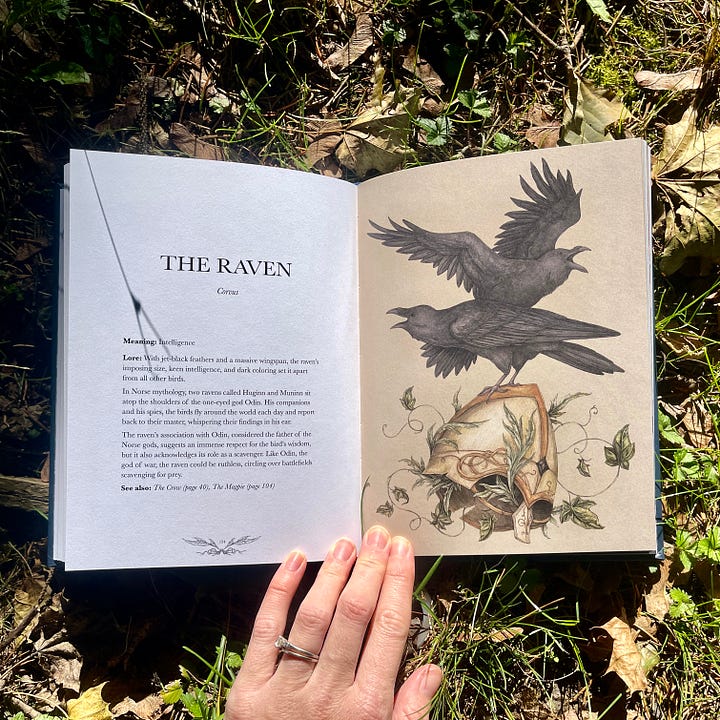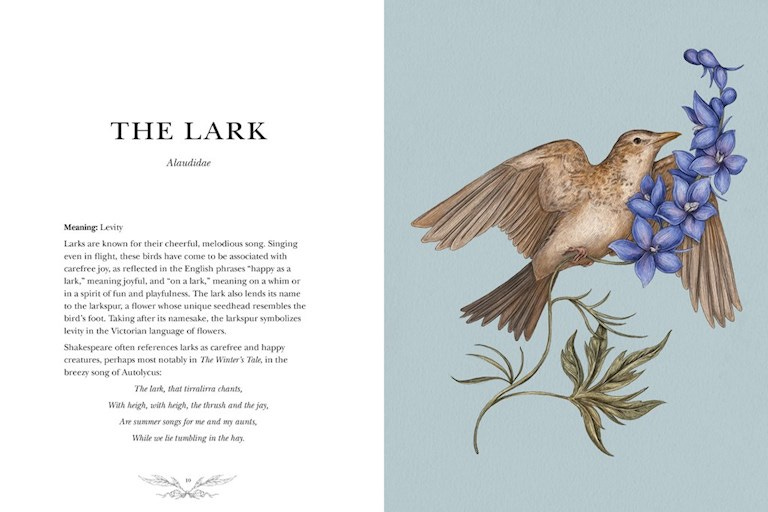October Book Review: Ornithography
An illustrated celebration of bird folklore by Jessica Roux
Welcome to the inaugural edition of The Nature Art Book Club! This month, we’ll be diving into Ornithography: An Illustrated Guide to Bird Lore & Symbolism by the amazing Nashville author and illustrator, Jessica Roux. I interviewed her for this review, so you’ll get some behind-the-scenes tidbits in Jessica’s own words.
I worked at an art gallery called Bloom in 2019, and we carried Jessica’s first book and art prints. I loved organizing and restocking her section of the shop, since it meant that I got to spend more time with her art! Since then, we’ve been internet friends and it’s been such a joy to watch her artwork evolve. I also own her previous book, Floriography: An Illustrated Guide to the Victorian Language of Flowers, so I pre-ordered this book when I saw it announced this spring (it just came out in September!).
Ornithography combines 100 illustrations of birds with traditional folklore and meanings associated with each bird. It’s the perfect book to keep on your nightstand or coffee table, reading a few entries here and there while you sip some tea. It’s a book to savor.


Rosalie Haizlett: Hi Jessica! First of all, Ornithography is gorgeous. I’ve loved all of your books up until this point, so I pre-ordered this one as soon as you announced it way back in the spring. To kick off my questions, I’m first curious if you have a favorite bird that you illustrated for the book?
Jessica Roux: My absolute favorite illustration from the book is the Magpie. It’s the first illustration I created for Ornithography and was included in my book proposal, so I spent a lot of time getting the poses of the four magpies just right.
The four ribbons circling around the birds relate back to 18th century British nursery rhyme, One for Sorrow:
One for sorrow, (the black ribbon)
Two for joy, (the yellow ribbon)
Three for a girl, (the pink ribbon)
Four for a boy. (the blue ribbon)
I just love magpies: their striking black and white feathers, chattering calls, and intelligence draw me right in! The first time I saw one in person, I was charmed by their goofy little hops along the ground. They really are fun birds.
Rosalie: The magpie illustration caught my eye, too! It captures the chaos of when a flock of birds lands all at once, especially when they’re all fighting over food on the ground.
I’m curious about your artistic technique for this project. I know that for most of your previous artwork, you’ve used a combination of digital and analog methods. Is this how you created all the illustrations for this book, too?
Jessica: I work in a half traditional, half digital medium. I start first by creating a detailed graphite pencil drawing. This helps me capture all the texture and details, like delicate feathers and sharp talons. It also helps establish the value pattern, or the range of light to dark in each illustration.
Once the pencil drawing is complete, I scan it in and digitally paint in Photoshop to add color. I use a tablet with a stylus to do this, so it feels very similar to creating a painting traditionally. Working in this method allows me to make changes for clients quickly, and it makes sure all those pencil lines remain visible in the finished piece.


Rosalie: I think that’s a brilliant combination, because it gives you flexibility for editing and speeds up your process while also allowing you to start each piece with good ol’ fashioned paper and pencils. I also LOVE having that analog aspect to my art practice. The graphite + digital combo also gives you such a clearly distinguishable style! There have been many times that I’ve been out and about and seen a calendar or editorial illustration, and I instantly think: that’s Jessica Roux! And it always is.
I wonder how the research process for this one compared to that of your previous book, Floriography? Did you find that there was more information available about the folklore of birds or flowers?
Jessica: What was interesting about the research process is that, for Floriography, we have a defined language of flowers that emerged in the Victorian era. Each herb and bloom had a meaning assigned, often taken from history, mythology, folklore, or the characteristics of the plant itself, which I explored in the research and writing of the book.
For Ornithography, we don’t have a standardized language of birds to pull from. Instead, I researched the myths and stories of birds from many different cultures and sources. Not having a base to pull from definitely made it more challenging! That being said, around the world, humankind has had this lasting fascination with birds: telling stories about them, assigning them meanings, and interpreting their movements and calls. Uncovering and sharing these stories was so much fun, and I learned so much in the researching process!
Rosalie: Wow, that lack of standardized info would make this a much more research-heavy book! Well, I personally really like the way the book unifies many different cultures around a shared reverence for birds. This makes me wonder what an alternate version of Floriography would be like if it were written about the meanings of flowers throughout many cultures and eras, not just during Victorian times. I wonder how much crossover there would naturally be, just based on the scents and appearance of each unique flower? Sounds like an internet rabbit-hole I need to explore. :)
Thanks for your time, Jessica! Excited to see what you make next.


It’s tough to pick favorites, but I’m most drawn to the illustrations that have a lot of movement. This is something that I’m trying to incorporate more into my own artwork, so I love seeing examples of how Jessica has achieved this through the fluttery movement of wings, the expressive faces on the birds, and the integration of non-bird objects that flow and create energy, like the ribbon and vines in the spreads above and below.


Thanks for joining us for our October nature book review, and shoutout to Jessica for answering my questions. The comment section is OPEN! I’d love to hear your thoughts on the artwork, theme of the book, or even your favorite birds or other bird illustrators you admire. :)
See you in November! Until then, stay cozy. 📖☕️
-Rosalie














Art, nature and books. What could be better?! I know I’m going to love this. Thanks for introducing me to a new (to me) author. I can’t wait to checkout both books.
This is such an amazing book. Thank you for sharing your thoughts! I love this club!!